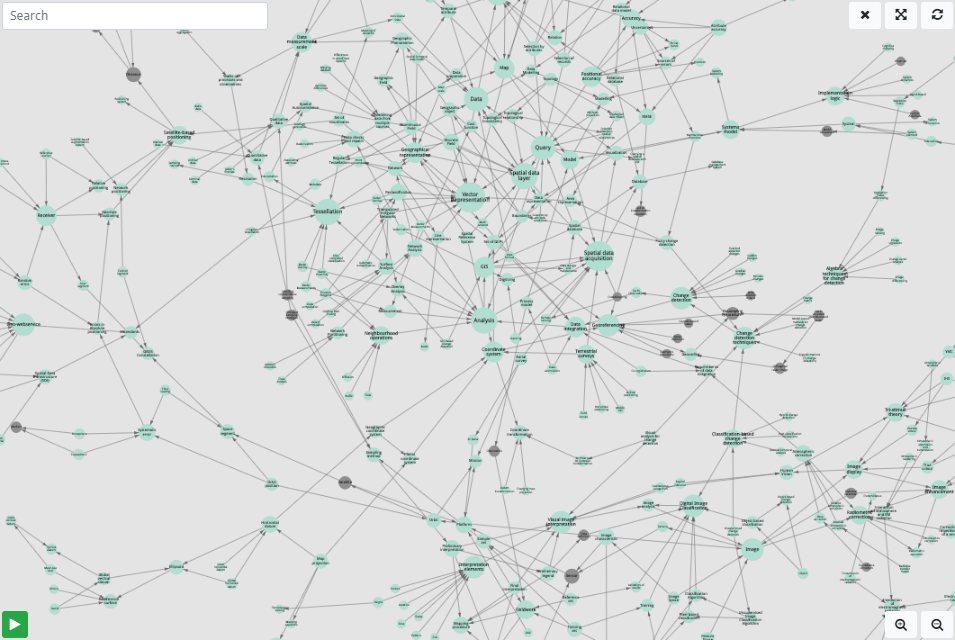Learning concepts as the brain wants to see them
The Living Textbook is a novel way to display content digitally. It combines the versatility of a wiki with the visual representation of concepts and their relationships. It allows experts to create a mind map of their domain and offers learners the freedom to explore concepts through their relationships.
BROWSE A LARGE LIST OF CONCEPTS The Living Textbook allows you to visualize information in a large map of concepts and understand the relationships between them. After finding a concept, the description of this concept is shown in the Wiki part of the Living Textbook. |
|
| ORGANIZE CONTENT FOR A LECTURE USING LEARNING PATHS Learning paths allows the lecturer to create a single linear stream of concepts to mirror the content presented in a lecture or to highlight a particular topic. It allows students to focus on a particular path in the content map, but never takes away the freedom to explore concepts outside of this path. |
ANNOTATION Within the Living Textbook, students can highlight text and concepts in the wiki and concept map. They can add comments to themselves, share comments with peers, or with their teachers. This functionality can be used to facilitate discussion based on the textbook. |
|
| LEARNING ANALYTICS The living includes functionality for tracking student movement during courses. This information can be visualized by means of a Teacher Learning Analytics dashboard to help teachers analyze student learning behavior and improve their classes. |
COLLABORATION For a particular project or course you can set up a team of collaborators and create a specific study area in which you can arrange roles for editors, viewers and reviewers. |
|
Interview with Marie-José Verkroost
Marie-José, leader of the Living Textbook project explains the theory behind the software and walk us through the interface and some of the most important features.
Publications related to the Living Textbook:
Space Education with The Living Textbook, A web-based tool using a Concept Browser
Lemmens, R. L. G., Ronzhin, S., Augustijn, P. W. M., Verkroost, M. J. & Walsh, N., 2018. 4 p.
The Living Textbook: Towards a new way of Teaching Geo-Science
Augustijn, P. W. M., Lemmens, R. L. G., Verkroost, M. J., Ronzhin, S. & Walsh, N., 2018, AGILE 2018 : Proceedings of the 21st AGILE Conference on Geo-information science Lund, Geospatial technologies for all. Lund: Association of Geographic Information Laboratories for Europe (AGILE)
Temporal Trends in Textbook Tracking Data
Augustijn, P. W. M., Verkroost, M. J., I. Oliveira , 2020, SEFI: Proceedings of the SEFI 48th Annual Conference.
(Click here to access the paper)
Body of knowledge for the earth observation and geoinformation sector: A basis for innovative skills development
M. A. Stelmaszczuk-górska, E. Aguilar-moreno, S. Casteleyn, D. Vandenbroucke, M. Miguel-lago, C. Dubois, R. Lemmens, G. Vancauwenberghe, M. Olijslagers, S. Lang, F. Albrecht, M. Belgiu, V. Krieger, T. Jagdhuber, A. Fluhrer, M. J. Soja, A. Mouratidis, H. J. Persson, R. Colombo, G. Masiello
Complementing the European earth observation and geographic information body of knowledge with a business‐oriented perspective
Barbara Hofer*, Sven Casteleyn, Estefanía Aguilar‐moreno, Eva‐maria Missoni‐steinbacher, Florian Albrecht, R. Lemmens, Stefan Lang, Jochen Albrecht, Martyna Stelmaszczuk‐górska, Glenn Vancauwenberghe, Aida Monfort‐muriach







